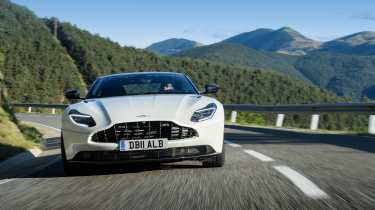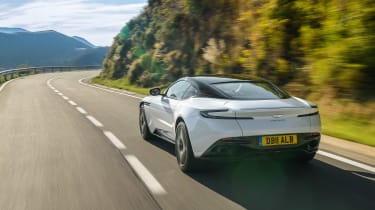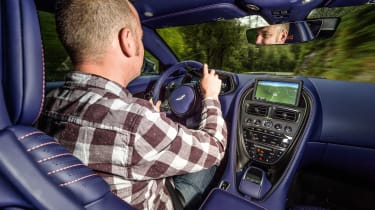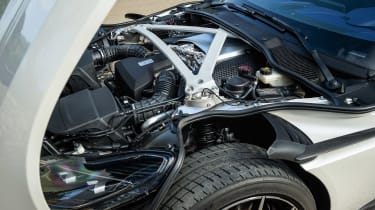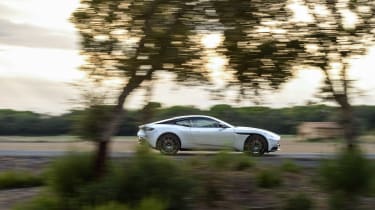Aston Martin DB11 V8 review – is less still more when applied to a suave GT?
Addition of Mercedes V8 means same performance as V12 for less cash, while chassis modifications have sharpened the driving experience
When it debuted late in 2016, the DB11 represented a bold new dawn for Aston Martin. It replaced the long-serving DB9 and was the first model to debut the brand’s all-new twin-turbocharged V12. Plus, it bore the first fruits of Aston’s tie-up with Mercedes Benz, with much of the German brand’s electrical architecture finding its way under the striking skin of the DB11.
However, that relationship has been taken a step further with the new DB11 V8, which is powered by the same 4-litre V8 that’s usually found under the pugnacious nose of the Mercedes-AMG C63 S. Aston Martin claims this engine makes the DB11 V8 more of a driver’s car, while the V12 remains the ultimate grand tourer. This statement is backed up by the fact that Aston Martin’s chassis guru Matt Becker and his team have made numerous tweaks to the chassis with the aim of sharpening the dynamics.
> Click here for the latest spy shots of the all-new V8 Vantage
What’s more, Aston has also worked hard to eliminate the quality glitches that blighted early V12 machines – a crucial move given the DB11 is aimed squarely at the forthcoming Bentley Continental GT.
Technical highlights
Without doubt the most interesting technical aspect of the DB11 V8 is that new engine. Not since the 1994 DB7 with its Jaguar XJS sourced straight-six has Aston taken an off-the-shelf powerplant. Yet Aston makes no bones about the new twin-turbo 4-litre V8’s heritage, revealing that the only things it changes are the engine management software and the sump, which is much shallower in an effort to lower the centre of gravity and fit the unit under the slinky body.
More reviews
Still, the exhaust system is pure Aston and has been tuned to deliver a more cultured sound that’s better in keeping with the DB11’s brief as a grown-up grand tourer. Engineers have also stuck with the V12’s transaxle eight-speed automatic transmission, rather than take Mercedes’ seven-speed unit.
> Click here for our review of the Aston Martin DB11 V12
Yet while the changes to the engine are virtually non-existent, its installation has resulted in numerous chassis changes. For starters, the V8 and its various ancillaries are around 115kg lighter than the V12, plus it’s shorter and so sits further back in the chassis – weight distribution is now 49/51 front to rear, compared to 51/49 for the V12. The springing and damping have been subtly altered to compensate for the reduction and relocation of the masses, but there have also been tweaks aimed at delivering greater handling precision and more driver involvement.
To this end there are stiffer rear suspension bushes, plus stronger camber links, while the mapping for the electric power steering has been altered to add extra weight. Finally, to compensate for the V8’s less hefty nose the pistons used in the six-pot front brake calipers have been made a little smaller. The good news for all prospective DB11 owners is that all of these mods, with the exception of the brakes, will be rolled out across the whole range over the next year or so.
Aston also claims that it has made big strides in quality, and certainly the hand-finished interior looks and feels beautifully appointed. The Mercedes switchgear and TFT screens are also well integrated, with only the brand’s single wiper and indicator stalk sticking out like a sore thumb.
Engine, transmission and 0-62mph time
If you didn’t know that Aston had entered into a partnership with Mercedes, then you’d never guess the DB11 V8 was powered by the same unit used in the bombastic C63 S. It has the same 503bhp peak power output, but remapping the ECU has resulted in a more linear torque delivery, with 498lb ft of muscle available from just 2000rpm. There’s a similarly theatrical flare of revs as the engine catches, but then it settles down to a much more subdued idle than in the Merc. This lower key approach continues on the move, where the DB lacks the deep, American muscle car burble of the Merc, favouring instead a more cultured approach. Squeeze the throttle, though, and the 4-litre unit takes on a more aggressive timbre, but it’s more tenor than the C63’s ear-bashing baritone. Switching to Sport or Sport+ mode increases the volume and adds some entertaining pops and bangs on the overrun, but even as you home in on the redline the V8’s bellow stays the right side of anti-social. It’s not without its quirks, however, as on a trailing throttle at very low speeds, the faint gurgle from the exhaust sounds strangely like the mechanical grumble of worn differential. Bizarre.
The V8 is fast, though, with Aston claiming the 0-62mph sprint is all over in 4.0sec, which is just a tenth slower than the V12. However, the V8 revs more freely than the V12, while its thumping torque peak of 498lb ft (516 for the V12) is on tap from just 2000rpm – all of which means it feels more responsive to your right foot. In fact, it’s so potent low down that you need to be fairly restrained with your throttle applications if you don’t want to send the traction control into overdrive. Get the Bridgestones hooked up, though, particularly in the higher gears, and the V8 delivers a relentless surge of acceleration. In terms of real world pace, there’s virtually nothing to separate this model from the V12.
> Click here for our last review of the Aston Martin DB9
The eight-speed transaxle auto is carried over unchanged, but the steering column mounted paddle-shifters have 50 per cent less travel, making for faster and more responsive feel when you want to take control of shifts, which are barely any slower than an equivalent twin-clutch unit. Leave the transmission to its own devices and it slurs ratios as smoothly as you’ll want.
What’s it like to drive?
Ignore the pictures attached to this story, because the weather during our Spanish test drive was pretty awful, with the only change in condition being the switch from light to heavy rain. As a result, we’ll have to wait until we drive the V8 in the UK in more clement conditions before building a truly accurate picture of the Aston’s dynamic abilities. However, until then the low grip conditions did at least give us the chance to discover any handling vices that might have been hidden if it’d been bone dry.
The V8 gets the same steering rack as the V12, which mean it's fast at 2.4 turns lock-to-lock, but recalibrating the electric assistance has resulted in a meatier feel, boosting confidence. And while it was difficult to judge outright grip in the slippery conditions, the DB turns in crisply and clings on well provided you don’t push too hard. You need to be more careful on the exit of corners, though, where the twin turbo’s terrific twist action makes it all to easy to spin-up the rear-wheels. On the plus side, the Aston feels extremely well balanced, while any transition from grip to slip is well telegraphed.
Ramp up the damper stiffness by selecting Sport or Sport+ modes via the steering wheel-mounted button (you can do this independently of the similar settings for the steering, throttle map and gearshift strategies) and the Aston feels taut and controlled over undulating roads.
Thumb the damper button into Comfort and the Aston rides for the most part with impressive suppleness, bolstering its grand touring credentials. Yet while it’s particularly adept at soaking up bumps on smoothly surfaced motorways, the DB’s ride becomes firm and fidgety over scarred and pockmarked tarmac. Our car also suffered from some irritating wind rush from a rubber door seal at the base of the A-pillar; an issue that was only made obvious because the interior was otherwise a calm and quiet place to be on a long run.
Price and rivals
The DB11 V8 weighs in at a not inconsiderable £144,900, which places it firmly in the crosshairs of the current but soon to be replaced Bentley Continental GT V8. The Mercedes-AMG S63 Coupe, which uses much the same engine, costs £130,680 but is arguably less desirable than either of the British machines. A sterner rival could be the forthcoming £138,060 Mercedes-AMG GT C, which delivers 549bhp and is packed with upgrades from the track focused GT R.
Yet perhaps the DB11’s closest rival is its V12 big brother, which is barely any faster, offers no real improvements in comfort or refinement and costs £13,000 more.
